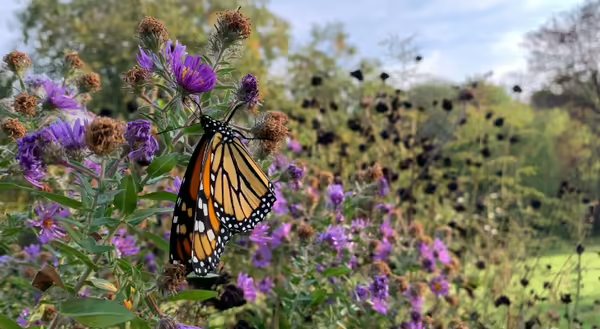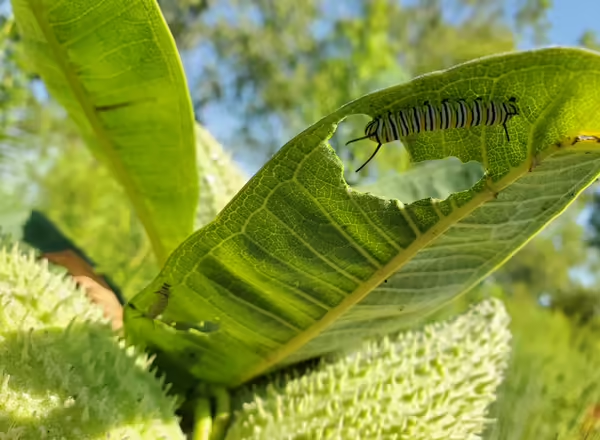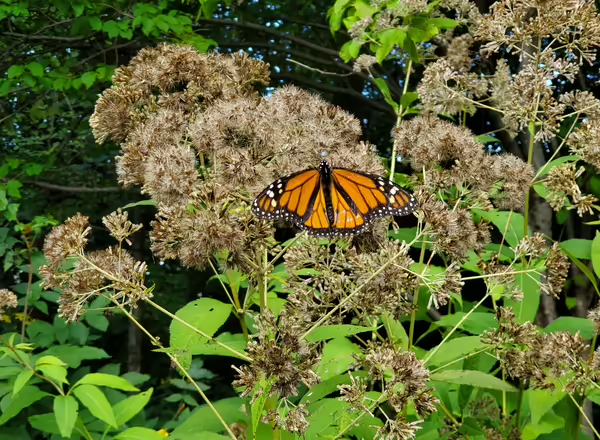
Throughout the summer, I talked to quite a few people who were concerned about the low numbers of monarch butterflies this year. Some of this concern was sparked early in the year when we learned that the overwintering monarch population in Mexico was measured at near all-time low numbers. When folks weren’t seeing monarchs in their gardens during the early summer, it really fueled concern.
In my own observations, I did see some monarchs in the late spring, around the end of May, and felt reassured at that time. Over the summer months, however, I just wasn’t seeing any on our property. I regularly frequent local natural areas and found a similar absence of monarch butterflies in places where I’ve traditionally seen them thrive.
Overwintering Data and Population Trends
Now, I will be the first to admit that my observations are very non-scientific or systematic, but for whatever reason, there were no monarchs in the places where I typically observed nature. I have heard similar reports from other gardeners and naturalists around central Illinois.
Each year, biologists monitor overwintering monarchs in Mexico by measuring the hectares occupied by the roosting rabble of butterflies. This past winter, the area measured was the second lowest recorded (0.9 hectares) since complete records were started in 1994 (the all-time low was in 2013-2014 at 0.67 ha). The highest amount recorded was in 1996 at 18.19 ha. Some form of monitoring has been going on since the 1970s, but it’s only been in more recent times that consistent, comparable record-keeping methods have been in place. Click here for more on monarch overwintering data.
A closer look at the data also reveals that overwintering monarch populations do show some cyclical highs and lows. So, if it’s any consolation to those worried about low winter counts, this latest dip seems to be part of a downward trend in recent winters. Hopefully, we will see an upward trend in the years ahead.

However, overwintering numbers don’t tell the whole tale of monarch decline. Scientists have also monitored summer breeding populations and migrating populations to try and paint a clearer picture. There is currently some debate as to which monitoring method most accurately captures what’s going on with the overall population, but these measures are certainly all pieces of the puzzle.
Again, there is a bright spot in the data when it comes to other monitoring measures. Researchers are seeing a summer population rebound each year that appears to bring numbers back up despite lower overwinter numbers in some years.
Monarchs have a vast summer breeding range that stretches across North America, well into Canada. During the summer months, these areas seem to be productive enough to regain much of the lost population, which is really encouraging.
However, the question of how low overwinter numbers can dip remains. At some lower limit, there will not be enough successful migration north to fuel the summer rebound, and we are unsure where that lower limit may be.
Over the last month or so (since early August), I have started to see monarchs again, and it is such a refreshing sight. To me, this is a sign that the summer rebound has been effective. Hopefully, as more migrating monarchs travel through our area, we will start to see a healthy population moving south.

Researchers have identified two primary factors that are believed to impact monarch populations. First is the availability of milkweed in summer breeding areas, which used to be thought of as the primary limitation. There is a very clear relationship in the data between the introduction of herbicide-resistant corn and beans in the 1990s and plummeting monarch populations. This landmark change in agricultural systems greatly increased our ability to control weeds, which greatly reduced milkweed abundance in the landscape.
The second factor or limitation that has been identified relates to the availability of floral resources (nectar-producing flowers) along the monarch’s migration route. The energy for migration is fueled by available nectar, and as we’ve seen monarch habitats shrinking over time, floral resources have also declined. It’s debatable which of these two factors is the primary driver of decreasing monarch populations, but we can all agree that both play a part.
Perhaps the best news to gardeners interested in supporting monarchs is that we can do something about either of these factors. Many of us already do this, but it's pretty easy to integrate more milkweed into our landscape design or add them to local natural areas. For support of migrating monarchs, gardeners can plant fall-blooming perennials that provide all-important nectar this time of year.
So, let's all keep our fingers crossed for a healthy migrating population across central IL this fall and be sure that fall-blooming garden plants are in tip-top health for maximum nectar production.
Top Photo Caption: This monarch butterfly feeds on a fall favorite, New England aster (Symphyotrichum novae-angliae), which provides an incredibly important source of nectar for migrating monarchs. Photo by Karla Griesbaum.